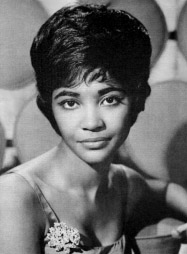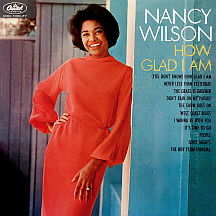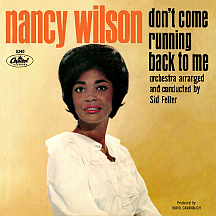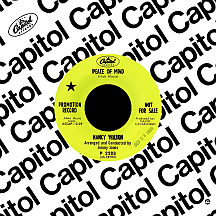NANCY WILSON
Throughout her career, Nancy Wilson insisted, over and over, that she preferred to be called a "song stylist" - not a singer of jazz, pop, rhythm and blues or any other category. She also admitted the term had an uncertain definition that should be left to the preference of each individual listener. Nancy wasn't a songwriter (she didn't read music), nor an arranger or producer, and she didn't excel at any particular instrument. Vocals were her entire focus. Songs she liked were chosen and delivered according to her own personal whims. Many single releases were original compositions taken from demo recordings or lyric sheets, while the bulk of her album tracks (and she made many albums!) were covers of the era's hits or remakes of classic standards. I've never heard a recording of hers that felt like an imitation of the original, in arrangement or vocal approach. Song Stylist Nancy Wilson always delivered a unique performance.
Born in 1937 in Chillicothe, Ohio, Nancy was the oldest of six children. The family later moved about 50 miles north to Columbus, her parents split up several years later and after reaching adolscence she left her mother's Pentecostal church for a nearby Methodist church, drawn by the opportunity to sing with its choir. As a teenager she was influenced by Ruth Brown and Dinah Washington, in addition to Cleveland-born male vocalist "Little" Jimmy Scott. In January 1952, shortly before turning 15, Nancy made her first public performance, singing "I Ran All the Way Home" at a West High School student show, which was open to the public for an admission price of 50 cents. Soon afterwards she tried out for a local talent show but the people running it recommended her instead for a spot on a 15-minute TV series, Skyline Melody; she appeared twice per week for the next three months.
With her mother's approval, Nancy worked occasionally in area nightclubs while attending high school. In the fall of 1954, she enrolled at Central State College in Wilberforce, Ohio but dropped out after one semester, opting to take a job singing at the Carolyn Club with Columbus-area bandleader Rusty Bryant (whose popular recording "All Nite Long" had appeared on Dot Records several months earlier). There she developed the instinctive stage movements that became an integral part of all live performances. In June 1956 she made her first and only record for Dot, "Don't Tell Me," doing the lead vocal with Bryant and his Carolyn Club Band. She toured with the act for two years, mostly in the midwest's Rust Belt region, and occasionally sat in with other groups in Columbus clubs. While gaining confidence, Nancy took slow, calculated steps towards eventual success.
A chance meeting with Julian "Cannonball" Adderley in 1958, while visiting New York City with Rusty's band for some recording and gigging at Marty's 502 club, had lasting consequences. "Cannon," as she called him, was at that time in the process of making records with trumpeter Miles Davis, leading to the milestone jazz albums Somethin' Else (on Riverside with Adderley top-billed) and Kind of Blue (Davis credited as lead on what became a benchmark of the Columbia Records catalog). Nancy moved to New York in August 1959, returning to the 502 Club, improvising songs onstage with new bestie Adderley. She worked a day job for Triangle Leather Goods (pioneers in designer handbags!), then as a switchboard operator and secretary at the New York Institute of Technology. But her main goal after arriving in Manhattan was to convince Adderley's manager, noted band bassist John Levy, to represent her.
A break came in 1959 when Nancy filled in for Irene Reid, the house singer at the Blue Morocco, an exclusive night spot on East 54th Street, several blocks from Times Square. After a little needling from Adderley, Levy reluctantly went there to see her. You see, Dakota Staton was on his talent roster and he just wasn't keen about the idea of taking on another "girl singer," but then he heard Nancy's rendition of "Guess Who I Saw Today" and changed his mind. Immediately booking her into a studio with premier pianist Ray Bryant, four demo recordings, including "Guess," were made. She went back to her secretary job while he sent the demos to "Big" Dave Cavanaugh of Capitol Records. She was signed and recorded her debut album, Like in Love, in December 1959.
Capitol execs were so pleased with those first recordings that they made Nancy a priority, promoting her music to pop, jazz and top 40 stations while booking their new find into different types of venues from small nightclubs to large auditoriums. From the start, she was more of an album act; the only pre-1961 single was a promotional disc, "Who is the Capitol Mystery Artist?," sent to stations with the uncredited "Something Wonderful Happens" prior to the release of her second LP, Something Wonderful. A collaboration with The George Shearing Quintet, The Swingin's Mutual!, came the following year, as did three 45s including "Guess Who I Saw Today."
A breakthrough came when she joined her sax-playing pal for Nancy Wilson/Cannonball Adderley, an early '62 longplay release. "Save Your Love For Me," penned by Buddy Johnson, came off with a sonic vibe similar to the late-'50s Cannonball-and-Miles/Miles-and-Cannonball albums (featured players were bassist Sam Jones, pianist Joe Zawinul and Julian's brother, cornetist Nat Adderley); it was a hit that spring, just missing the top ten on Billboard's R&B charts. Nancy became such close friends with the Adderley family that they often got together at each others' homes to play pinochle late into the night.
Jazz Scene USA was a 30-minute syndicated TV series hosted by Oscar Brown, Jr. (who counted singing, songwriting, reporting and politics among his many vocations). An all-Wilson episode was filmed in the fall of 1962 and ran in various cities over the next few months (Adderley had his own episode as well). Jazz radio had been playing Nancy's songs for some time, but in 1963 she began getting airplay on Top 40 stations, starting that summer with "Tell Me the Truth." Her albums Broadway - My Way and Hollywood - My Way outsold earlier efforts, perhaps because they veered away from jazz and into the arguably more mainstream territories of musicals and popular songs. "What Are You Doing New Year's Eve" became a (non-Christmas) holiday season standard; the self-proclaimed "song stylist" rose to new heights in '64 with the top ten albums Yesterday's Love Songs...Today's Blues and Today, Tomorrow, Forever.
Summertime rolled around and with it came Nancy's all-time biggest hit: "(You Don't Know) How Glad I Am," a '...no beginning...no end...lost in the spin a-loving you' proclamation of romance with few equals in lyrics, timing, orchestration or vocal flair. You can thank Jimmy T. Williams (of "A Lover's Question" fame) and Larry Harrison for its existence. The single just missed the top ten during The Beatles' initial rush of fame and chart domination, while the album, How Glad I Am, reached new heights in sales. She won her first Grammy for the song at the April 13, 1965 awards ceremony in the mixed-gender category Best Rhythm and Blues Recording (triumphing over formidable competitors Sam Cooke, The Impressions, The Supremes, Joe Tex and Dionne Warwick). The song also landed her in contention for Best Vocal Performance, Female, up against a similar song-of-a-lifetime situation: winner Barbara Stresiand for "People."
Some great follow-up singles came from Nancy in '64 and '65, including her take on "I Wanna Be With You," a Charles Smith-Lee Adams tune from the Broadway musical Golden Boy and the Sid Tepper-Roy C. Bennett gem "Don't Come Running Back to Me." Her first live album, The Nancy Wilson Show!, bowed in early 1965, recorded at L.A.'s Coconut Grove with pianist Ronnell Bright. In March, she was one of a number of entertainers who joined Reverend Martin Luther King, Jr. on his protest marches from Selma to Montgomery, Alabama. For Nancy, who'd grown up in an integrated community in Ohio, the timing felt right for her to join this procession for racial equality. Any worries those around her may have had about it affecting her career came to naught; it was, quite simply, the right thing to do.

A few weeks later, on April 5, she appeared at the Academy Awards, the year's most-watched television event, performing the nominated song "My Kind of Town" (written by Jimmy Van Heusen and Sammy Cahn for the film Robin and the 7 Hoods, its best-known version was by Frank Sinatra). With so many albums (more than 40 total) came a lot of photoshoots, which kept her media image fresh. The cover of Today - My Way again illustrated the camera's affection for her as the album became a top ten seller. "Uptight (Everything's Alright)," her top single of '66, seemed unlikely, but she put her own stamp on the Stevie Wonder smash.
The increased popularity of color television in the mid-'60s, as the price of sets became more accessible, gave rise to many variety programs. Nancy made the rounds, appearing on The Tonight Show, The Hollywood Palace, the Bob Hope, Red Skelton, Andy Williams and Perry Como shows, The Smothers Brothers Comedy Hour, Dean Martin, Carol Burnette, This is Tom Jones and, lest I forget, The Ed Sullivan Show, among many others. With this frequent exposure came a resurgence on the pop and R&B charts with "Face it Girl, It's Over" (a top 30 hit) and "Peace of Mind" in 1968 and her version of Frankie Valli's hit "Can't Take My Eyes Off You" in '69
The 1970s saw a slight shift in her audience as she had success at urban/soul stations with several well-performing songs including "You're Right As Rain," a top ten Soul (formerly R&B) chart hit in 1975. She'd caught the acting bug some years earlier and producers were happy to oblige, leading to guest roles in dramatic series like I Spy, Room 222, Hawaii Five-O, The F.B.I., Police Story and others, in addition to a number of comedy shows, giving her an ongoing side career from the '60s through the early 2000s. Finally leaving Capitol after more than two decades, she recorded for Columbia Records between 1987 and '97.
From 1995 to 2002 she served as the host of Jazz Profiles, an NPR program dedicated to the history of jazz; the majority of the more than 200 hourlong episodes focused on one individual performer and many featured musicians Nancy had known and in some cases worked with during her early years in the business. Afterwards, she recorded for a smaller label, MCG Jazz, and won her second and third Grammy awards for the 2004 album R.S.V.P. (Rare Songs, Very Personal) and 2006's Turned to Blue, both in the category Best Jazz Vocal Album. She kept performing live for several more years, then settled into a quieter family life in the 2010s. Though Nancy Wilson has passed away, in some ways it doesn't feel like she left us. There are hundreds of recordings we, her fans, can find comfort in whenever we like.
NOTABLE SINGLES:
- Don't Tell Me - 1956
by Rusty Bryant and the Carolyn Club Band featuring Nancy Wilson - My Foolish Heart - 1961
- Guess Who I Saw Today - 1961
- Save Your Love For Me - 1962
by Nancy Wilson and the Julian "Cannonball" Adderley Quintet - Tell Me the Truth - 1963
- What Are You Doing New Year's Eve - 1963
- (You Don't Know) How Glad I Am - 1964
- I Wanna Be With You - 1964
- And Satisfy - 1964
- Don't Come Running Back to Me - 1965
- Welcome, Welcome - 1965
- Where Does That Leave Me - 1965
- I Only Think of Him When I Miss Him - 1965
- Uptight (Everything's Alright) /
You've Got Your Troubles - 1966 - Face it Girl, It's Over - 1968
- Peace of Mind - 1968
- In a Long White Room - 1968
- You'd Better Go - 1969
- Got it Together - 1969
- Can't Take My Eyes Off You - 1969
- This Girl is a Woman Now - 1970
- Now I'm a Woman - 1970
- You're as Right as Rain - 1975
- He Called Me Baby - 1975
- Don't Let Me Be Lonely Tonight - 1976




